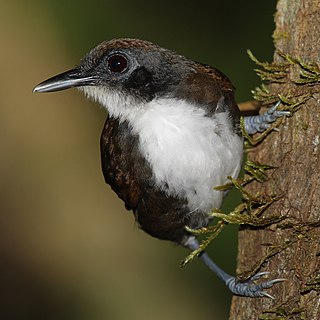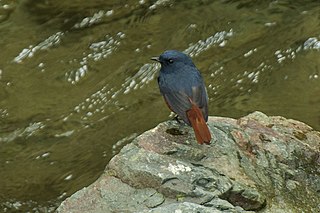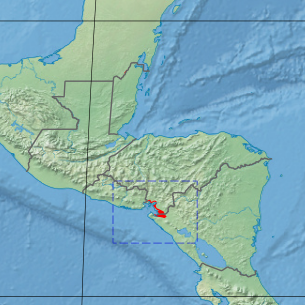
Loxocemus bicolor, the sole member of the monotypic family Loxocemidae and commonly known as the Mexican python, Mexican burrowing python and Mexican burrowing snake, is a species of python-like snake found in Mexico and Central America. No subspecies are currently recognized. Analyses of DNA show that Loxocemus is most closely related to the true pythons and the sunbeam snakes.

Avicennia is a genus of flowering plants currently placed in the bear's breeches family, Acanthaceae. It contains mangrove trees, which occur in the intertidal zones of estuarine areas and are characterized by its "pencil roots", which are aerial roots. They are also commonly known as api api, which in the Malay language means "fires", a reference to the fact that fireflies often congregate on these trees. Species of Avicennia occur worldwide south of the Tropic of Cancer.

Avicennia marina, commonly known as grey mangrove or white mangrove, is a species of mangrove tree classified in the plant family Acanthaceae. As with other mangroves, it occurs in the intertidal zones of estuarine areas.

Avicennia germinans, the black mangrove, is a shrub or small tree growing up to 12 meters in the acanthus family, Acanthaceae. It grows in tropical and subtropical regions of the Americas, on both the Atlantic and Pacific Coasts, and on the Atlantic Coast of tropical Africa, where it thrives on the sandy and muddy shores where seawater reaches. It is common throughout coastal areas of Texas and Florida, and ranges as far north as southern Louisiana and coastal Georgia in the United States.

Phyllomedusa bicolor, the giant leaf frog, bicolor tree-frog, giant monkey frog, or waxy-monkey treefrog, is a species of leaf frog. It can be found in the Amazon basin of Brazil, Colombia (Amazonas), Bolivia, and Peru, and can also be found in the Guianan Region of Venezuela and the Guianas, and in Cerrado of the state of Maranhão in Brazil.

The black-and-white mannikin also black-and-white munia or red-backed mannikin, is a species of estrildid finch, widely occurring throughout the African tropical rainforest. It has an estimated global extent of occurrence of 4,200,000 km2. It is found in moist savanna and subtropical or tropical moist lowland forest habitat. The status of the species is evaluated as least concern. They are seedeaters, but are known to feed on algae.

The bicolored antbird is a species of bird in the family Thamnophilidae. It is found in Honduras south to Panama, western Colombia and Ecuador. Its natural habitat is subtropical or tropical moist lowland forest.

The Luzon water redstart, also known as the Luzon redstart, is a species of bird in the family Muscicapidae. It is endemic to the Philippines found primarily on Luzon with no records in Mindoro since 1965. Its natural habitats are tropical moist lowland forest, subtropical or tropical moist montane forest, and rivers. It is threatened by habitat loss.

Avicennia officinalis is a species of mangrove also known as Indian mangrove. The genus Avicennia is named after the famous Persian scientist Ibn Sina.

Avicennia alba is a species of tropical mangrove in the family Acanthaceae. It is found growing in coastal and estuarine locations in India, Southeast Asia, Australia, and Oceania.
Avicennia rumphiana is a species of tropical mangrove in the family Acanthaceae. It is considered vulnerable by the IUCN Red List of Threatened Species in the 2008 assessment. As of March 2022, Plants of the World Online considered it to be only a variety of Avicennia marina, Avicennia marina var. rumphiana. In the Malay language it is known as api api bulu.
The bicolor false moray is an eel in the family Chlopsidae. It was described by George S. Myers and Charles Barkley Wade in 1941, originally under the genus Garmanichthys. It is a tropical, marine eel which is known from around the Galapagos Islands in the southeastern Pacific Ocean. Males are known to reach a maximum total length of 20 cm.

The South American Pacific mangroves, or Panama Bight mangroves, is an ecoregion along the Pacific coast of Panama, Colombia, Ecuador and Peru.

The Gulf of Panama mangroves (NT1414) is an ecoregion along the Pacific coast of Panama and Colombia. The mangroves experience seasonal flooding with high levels of sediment, and occasional extreme storms or very low rainfall due to El Niño effects. They are important as a breeding or nursery area for marine species. Areas of the mangroves have been recognized as Important Bird Areas and Ramsar wetlands. The ecoregion has been severely degraded by clearance of mangroves for agriculture, pasturage and shrimp farming, by urban pressure around Panama City, and by pollution related to the Panama Canal.
Rhizophora harrisonii is a species of plant in the family Rhizophoraceae. It can be found in Brazil, Cameroon, Colombia, Costa Rica, Ecuador, Guyana, French Guiana, Honduras, Nicaragua, Panama, Suriname, Trinidad, Tobago, and Venezuela.

The Gulf of Fonseca mangroves ecoregion covers the brackish mangrove forests around the Gulf of Fonseca on the Pacific Ocean. The Gulf is the meeting point El Salvador, Honduras, and Nicaragua. The Gulf is one of the two primary nesting sites of the critically endangered Hawksbill turtle in the eastern Pacific. In the Honduras portion, there are seven nature reserves that collectively make up a RAMSAR wetland of international importance, providing protection for migratory birds, sea turtle, and fish.

The Moist Pacific Coast mangroves ecoregion covers a series of disconnected mangrove sites along the Pacific Ocean coast of Costa Rica and Panama. These sites occur mostly on coastal flatlands around lagoons, particularly where rivers from the inland mountains reach the sea, bringing fresh water to the coastal forests. The area is in a transition zone from the drier coastline to the north; rainfall in this ecoregions is over 2,000 mm/year, and reaches over 3,600 mm/year at the southern end.

The Southern Dry Pacific Coast mangroves ecoregion covers a series of mangrove forests along the Pacific Ocean coast of Nicaragua and Costa Rica, from the southern margin of the Gulf of Fonseca to the Gulf of Nicoya near the border with Panama. Because the area is drier than the mangroves further south, evapotranspiration leaves some areas with higher salinity and even salt pans in the internal areas.
Avicennia integra is a species of tropical mangrove in the family Acanthaceae. It grows in coastal and estuarine locations in the Northern Territory, Australia.
Avicennia schaueriana is a species of tropical mangrove in the family Acanthaceae. It grows in coastal and estuarine locations along the Atlantic coast of northeastern South America, from Venezuela and the Leeward Islands through Trinidad and Tobago, the Windward Islands, the Guianas, and Brazil to Uruguay.















